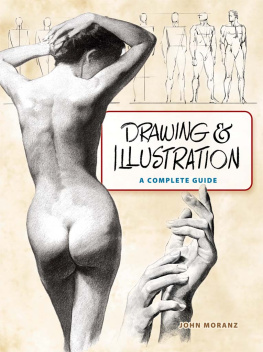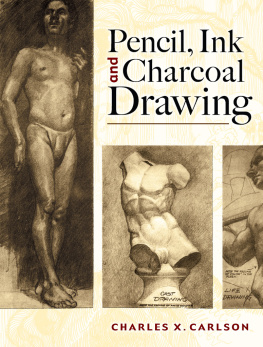DRAWING & ILLUSTRATION
A COMPLETE GUIDE
JOHN MORANZ
DOVER PUBLICATIONS, INC.
MINEOLA, NEW YORK
Bibliographical Note
This Dover edition, first published in 2008, is an unabridged republication of Mastery of Drawing, by John Moranz, originally published by Richard R. Smith Publisher, Inc., New York, in 1950. The color plates in the original edition can be found in the color section located between pages 208 and 209. They have been reproduced in black and white in their original position within the book.
Library of Congress Cataloging-in-Publication Data
Moranz, John, 1902
[Mastery of drawing]
Drawing and illustration : a complete guide / John Moranz.
p. cm.
Originally published under title: Mastery of drawing: New York : Richard R. Smith Publisher, 1950.
Includes index.
ISBN-13: 978-0-486-46606-4
ISBN-10: 0-486-46606-X
1. DrawingTechnique. I. Title.
NC730.M585 2008
741.2dc22
2007051583
Manufactured in the United States of America Dover Publications, Inc., 31 East 2nd Street, Mineola, N.Y. 11501
CONTENTS
NUDES IN COLOR
(See color insert after .)
PREFACE
T HERE IS present in each of us a compelling urge to express, in drawing or art of some kind, what we see, what we hear or what we think. The caveman had this urge and left his art scrawled or chiseled on the walls of the cavern he called his home. Down through the ages others have had this same compelling urge, and each era has left its record in picture, sculpture or architecture.
For some of us in these modern times, this urge may find expression only in scribbling in school books, doodling on telephone scratch pads, or putting mustaches on magazine cover girls. Others may have advanced from this stage to the point of beginning a serious study of art, and are looking forward to the time, coming soon, when they can turn their talent into a source of profit. And there are others who have already passed through the scribbling stage and the student period to join the ranks of the professional artists.
My experience shows that doodler, student and professional need a single book on drawing to which the doodler can go for training, the student for further help in developing his skill, and the professional for reference material.
It is to meet these needs that this book has been designed. It presents a comprehensive but simple study of the fundamentals of drawing in its various phases and fields, and an explanation of the methods, techniques and procedures commonly employed. This is done by means of as few and simple words and as many and varied drawings as possible.
In the major part of the book is presented material, the understanding and mastery of which are essential for all artists, but adequate treatment is given also to the practical application of these fundamental principles and techniques in the field of commercial art. Hence not only the newcomer in the commercial field, but also the established professional artist will find this volume extremely helpful on many occasions. Unusually full treatmentfor a general volumeis given to portraits, figure drawing and animals; to advertising layout and creating illustrations. Hands, perspective, composition and the draped figure are adequately discussed and illustrated.
Even the layman, who appreciates art but does not wish to practice it, will find his pleasure increased by the knowledge of the artists craft which he can gain from these pages.
Mastery of drawing is the necessary prerequisite to the effective use of color, but as there are now available a number of excellent books on painting, this subject has not been treated here. There have been included, however, reproductions in color of eight oil paintings to show the application of the fundamentals of figure drawing and to encourage the student in his efforts to master these fundamentals. Paintings from living models in the nude have been chosen for this purpose.
I am deeply grateful for the valuable assistance in the preparation of this volume which I have received from these professional colleagues of mine and others: Jack Cowan, Lou Segal, Henry J. Bracker, Becker Cline, A. D. Greer, Fried Pl, Frank Larocco, George S. Moranz, Vern Manson.
Success in art cannot be gained easily, but it is no more difficult to attain proficiency in drawing than to become expert in any other field. You who are students know that there is no formula which will assure your success. You have learned that art is an expression of a personality and that art devoid of personality has little reason to exist. It is my hope that you will find in this book the solutions of many of the problems which will confront you as you develop the skill to obey the urge to express your personality on paper or canvas.
Houston, Texas July, 1950 | J. M. |
SILENT INSTRUCTOR
L ET US ASSUME that you have a desire to draw and a belief that you will like the experience of learning to draw, but that you cannot attend an art school. How, then, can you make a start? Obviously, just by beginning to drawno matter what or how. And this book can be your silent instructor; it can help you to succeed if you are intent on success.
An artist is able to draw because he can seebecause he sees people and inanimate objects as surfaces or planes reflecting the light to which they are exposed. The layman only looks, but the artist seesperceives. The student must learn to see people and things in terms of pictures and to consider how he would put them on paper. This he can learn to do only by trying, for the hand will put down only what the eye and mind observe.
The purpose of this book is to open your eyes to what is around you. It seeks to give you honest help by avoiding the jargon of high-flown art talk, which is beyond the needs or understanding of the studentthe art of drawing is not an exact science.
The art school student asks his instructor what is wrong with his drawing, but the instructor insists that the student find his own mistakes. By becoming his own analyst and critic, the student starts on the only road to artistic achievement, and he may travel this road rapidly by the aid of this book as his silent instructor, because he is forced to develop, at the start of the road, his critical and analytical faculties.
The drawings in this book are reproduced on a large scale and with great clarity so that the student can analyze them, learn how the effects have been obtained, and determine which are basic and which individual strokes.
We speak of basic strokes because all human beings have in every part of their bodies more likenesses to each other than differences. The artist must be guided by this basic similarity and yet know how to put on paper the characteristic differences of the individual.
There are many mediums and many kinds of surfaces on which to use them. The four basic mediums are pencil, charcoal, pen and wash; and skill in the use of all is mandatory for any commercial artist.
PENCIL is the most natural because of its familiarity, but charcoal is easier to use because a stroke may be immediately removed by a sweep of a finger, while the pencil requires an eraser. Use a long pencil with long graduated pointnever a sharp point, and for most artists a flat, chiseled point is the favorite. Also a soft lead2 B or 3 B graphite. Other sketching pencils are of carbon or crayon.
The pencil should feel so comfortable in the hand that it seems like a continuation of the fingers and thus permits the mind to cause a free flow from the finger tips through the pencil to the paper. A stubby point or short pencil will break this flow and cause a halting, awkward movement. A hard point dents the paper and makes lines which are hard to erase. The best surfaces for pencil are bond, offset and layout papers.






